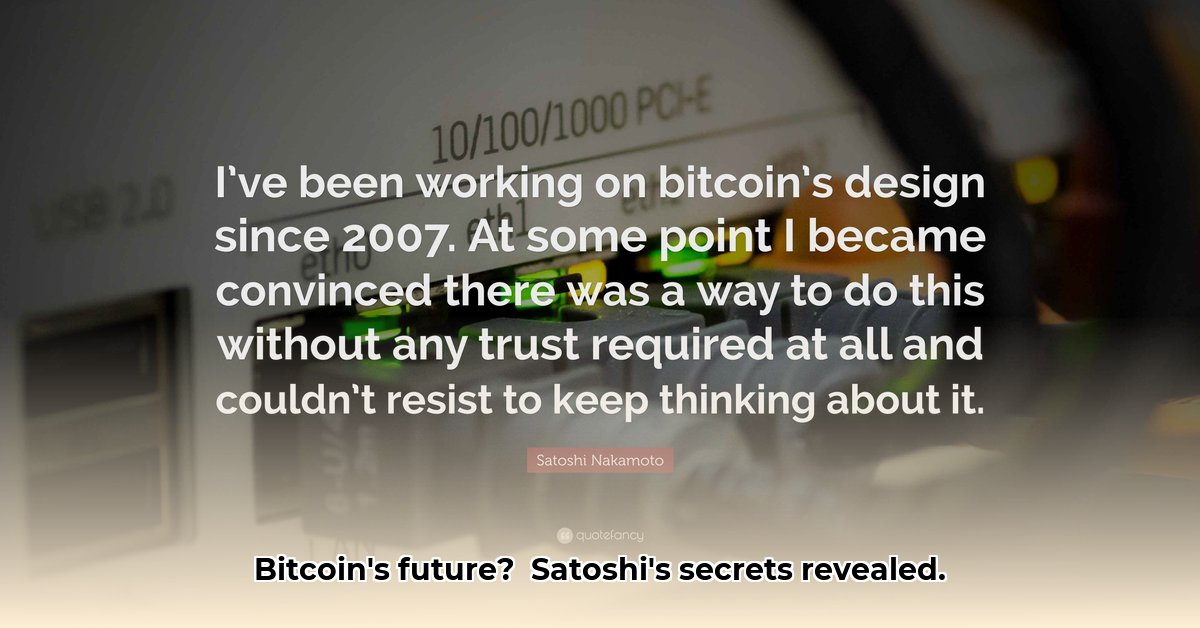Ever wonder what the mysterious Satoshi Nakamoto, Bitcoin’s creator, really thought? We’re diving into Satoshi’s own words, the quotes that laid the groundwork for Bitcoin as we know it. We’ll break down what he meant about a world without banks playing middleman, how he envisioned Bitcoin’s limited supply impacting its value, and what he thought about the tech challenges that still face Bitcoin today. Get ready to understand the core ideas behind Bitcoin, straight from the source!
Satoshi Nakamoto Quotes: Deciphering Bitcoin’s Blueprint
Satoshi Nakamoto, the enigmatic creator of Bitcoin, left behind quotations that offer insights into the digital currency’s design. While Nakamoto’s identity remains a mystery, their writings serve as a text for understanding Bitcoin’s philosophy and technological hurdles. Let’s delve into some core themes revealed through Nakamoto’s pronouncements regarding blockchain technology and cryptocurrency.
The Dream of a Decentralized World: Escaping Central Control
Nakamoto’s vision, as expressed in their statements, wasn’t just about creating a new currency; it was about constructing a financial system free from the power of central banks and governments. “The root problem with conventional currency is all the trust that’s required to make it work,” Nakamoto stated, highlighting the inherent risks of centralized systems. Imagine a system where transactions happen directly between people, without needing a bank to approve or control them: peer-to-peer transactions secured by cryptography. The quotes show a need for security, arguing that cryptographic techniques were the key to building trust in a system without central authority. This focus on security remains a principle of Bitcoin today: what are its strengths and weaknesses?
Nakamoto emphasized this point by saying, “I’ve been working on a new electronic cash system that’s fully peer-to-peer, with no trusted third party.” This foundational concept of decentralization aimed to return financial control to individuals, reducing reliance on traditional institutions. The very design of Bitcoin, with its distributed ledger and consensus mechanisms, embodies this principle.
Bitcoin’s Built-in Limits: Navigating Digital Scarcity for Long-Term Value
One of the most striking aspects of Bitcoin, as articulated in Nakamoto’s writing, is its inherent scarcity. Unlike traditional currencies governments can print, leading to inflation, Bitcoin has an upper limit: only 21 million coins will ever exist. This built-in scarcity, was a design choice, aimed at controlling inflation. The halving mechanism, where the rate of new Bitcoin creation is cut in half every four years, exemplifies this monetary policy.”Total circulation will be 21,000,000 coins,” Nakamoto explained. “It’ll be distributed to network nodes when they make blocks, with the amount cut in half every 4 years.”
Whether Nakamoto fully anticipated the potential for deflationary pressures is a topic of discussion, but the concept of a limited supply was clearly a design feature: how does it affect its market behavior? The inherent scarcity, further amplified by lost coins, led Nakamoto to suggest, “Lost coins only make everyone else’s coins worth slightly more. Think of it as a donation to everyone.” This perspective highlights the potential for increased value due to scarcity.
Tackling the Tough Stuff: Navigating Bitcoin Technological Challenges
Nakamoto acknowledged early challenges like scalability (handling a growing number of transactions), transaction fees, and energy consumption. These weren’t treated as insurmountable problems; rather, they were seen as design challenges requiring innovative solutions. Their writings serve as a roadmap that continues to guide researchers and developers today regarding bitcoin scalability. For example, the increasing popularity of Layer-2 scaling solutions directly addresses the early scalability concerns Nakamoto identified. These solutions are like adding extra highways to reduce congestion on the main Bitcoin road, allowing more transactions to be processed efficiently.
Nakamoto’s vision extended to transaction efficiency, recognizing that “Bitcoin isn’t currently practical for very small micropayments.” This awareness laid the groundwork for the development of solutions aimed at improving the transaction capabilities of the network.
Open Source: A Community-Driven Crypto Path
Nakamoto’s strong advocacy for open-source software is another crucial element. Open source means that everyone can access and examine Bitcoin’s code, contributing to its development and auditing its security. This transparency allows the community to identify and fix flaws, making the system more secure and resilient. However, an open-source approach also brings its own set of challenges. Managing a global community’s contributions, ensuring code updates, and reaching consensus are ongoing hurdles. Openness breeds collaboration, but also necessitates careful governance: what impact does this have?
Nakamoto clearly stated the necessity of open source when noting, “Being open source means anyone can independently review the code. If it was closed source, nobody could verify the security. I think it’s essential for a program of this nature to be open source.” This philosophy has been integral to Bitcoin’s development and security.
The Unanswerable Question: The Enduring Mystery of the Bitcoin Creator
The identity of Satoshi Nakamoto remains one of the most persistent mysteries in tech history. While various theories exist, the truth remains elusive. This mystery is perhaps a fitting conclusion to the story of Bitcoin. The focus now lies on the impact of their work and the continuing evolution of the project. Nakamoto’s vision continues to shape the course surrounding Bitcoin and its future. Analyzing Nakamoto’s quotes is like deciphering a roadmap for a technology that’s still being built, a testament to the mystery that surround this figure.
Even amidst the mystery, Nakamoto directly refuted claims of their identity, stating clearly, “I am not Dorian Nakamoto.” This further obscures their identity and reinforces the focus on the technology itself rather than the individual behind it.
Bitcoin’s Evolution: A Snapshot
| Aspect | Nakamoto’s Vision (as reflected in their statements) | Current Status | Ongoing Challenges |
|---|---|---|---|
| Decentralization | A system independent of central control; peer-to-peer transactions. | Partially achieved; debate about mining centralization. | Maintaining decentralization as the network grows larger. |
| Monetary Policy | Fixed supply of 21 million coins; halving to control inflation. | Implemented; discussion on deflationary pressures. | Understanding the long-term economic effects of Bitcoin’s scarcity. |
| Scalability | Identified as a critical challenge. | Actively being improved with Layer-2 solutions. | Balancing increased transaction throughput with security. |
| Energy Consumption | Concern expressed; a need for better solutions. | Remains a concern; research into greener solutions. | Finding sustainable consensus mechanisms. |
| Open Source Development | Essential for transparency, community involvement, and security auditing. | Remains a core aspect; community governance evolves. | Ensuring the management of community contributions. |
Satoshi Nakamoto’s legacy extends beyond the creation of Bitcoin. Their words provide a source for understanding the philosophy and ongoing evolution of this technology. The exploration of their quotes remains a journey of discovery, influencing the future of Bitcoin and digital currencies.
How to Mitigate Bitcoin Mining Energy Consumption Risks: The Green Shift
Key Takeaways:
- Bitcoin’s energy usage is a significant concern, impacting its environmental footprint. Measurement remains challenging due to market factors.
- Mitigating bitcoin mining energy consumption risks involves a multifaceted approach including incentivizing renewable energy.
- International cooperation and regulation are vital for lasting change. National policies are insufficient.
- The interplay between Bitcoin’s price volatility and miner incentives influences energy consumption. Higher prices often lead to practices.
The Vision of Decentralization: A Power Struggle?
Satoshi Nakamoto’s vision of a decentralized system is core to Bitcoin’s design. But this very decentralization creates a challenge. The energy-intensive Proof-of-Work algorithm raises questions about sustainability. How might they have addressed them, given today’s environmental concerns, when discussing sustainable cryptocurrency? While Nakamoto didn’t explicitly address the environmental impact, the potential for Bitcoin to “reduce spam by diverting zombie farms to generating bitcoins instead” suggests an awareness of the interplay between Bitcoin and resource utilization.
Monetary Policy and Scarcity: A Balancing Act
Bitcoin’s limited supply affects its value and, indirectly, its energy consumption. The halving mechanism, impacting miner behavior. Will this inherent scarcity ultimately force miners toward energy-efficient solutions? Or will it drive them to seek cheaper, less sustainable power sources? This is a key factor in understanding Bitcoin energy consumption. Nakamoto’s belief that “the price of any commodity tends to gravitate toward the production cost” implies that energy efficiency would ultimately become a critical competitive advantage for miners.
Technological Challenges and Solutions: The Path Forward
Nakamoto’s early writings likely didn’t explicitly address the scale of Bitcoin’s future energy demand. However, his emphasis on technological innovation suggests adaptation was inherent in his vision. Today, solutions like Layer-2 scaling and efficient mining hardware are central to mitigating bitcoin mining energy consumption risks. Could alternative consensus mechanisms, such as Proof-of-Stake, offer a more sustainable path regarding cryptocurrency regulation? Nakamoto’s vision included the idea that “Bitcoin generation should end up where it’s cheapest,” suggesting an eventual shift towards locations with access to renewable energy sources.
Open Source and Community: A Collaborative Effort
Bitcoin’s open-source nature facilitates innovation and transparency, essential for tracking energy usage and developing solutions. Without community participation, effective strategies are severely hampered regarding **bitcoin
- Unlocking Crypto Adoption Quotes Worldwide: Expert Insights & Future Trends - June 29, 2025
- Crypto Regulation Quotes: Expert Insights & Future Trends - June 29, 2025
- Buffett’s Crypto Quotes: Avoid a Bad Ending - June 29, 2025











